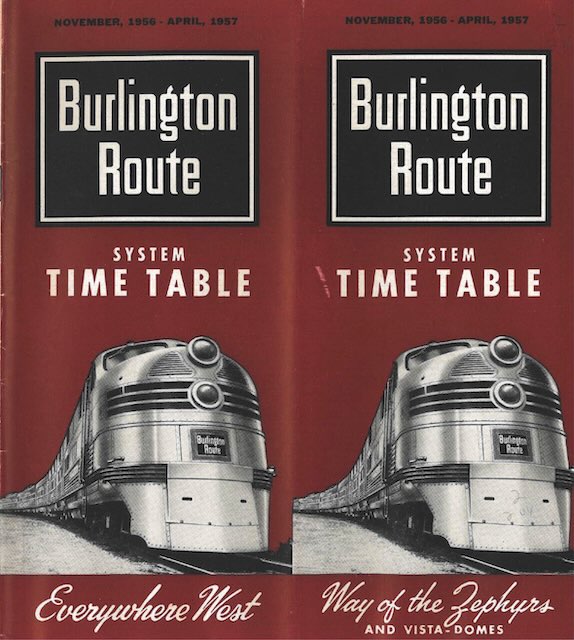Although the front cover of this timetable (scans for which were contributed by Bryan Howell) says it was for November 1956, the fine print on the inside front cover says that it went into effect on October 28. This is the same date that is on the front cover of yesterday’s Twin Cities timetable. Many of Burlington’s May timetables also went into effect in the last days of April.
 Click image to download a 21.6-MB PDF of this 36-page timetable.
Click image to download a 21.6-MB PDF of this 36-page timetable.
The back cover proudly announces the “the big new vista-dome Denver Zephyr,” which went into service on October 28. This was the last U.S. passenger train built as a single train until Amtrak and was something of a risk for Burlington. The deciding factor was that Union Pacific had introduced a new City of Denver in 1953 that ate into the Denver Zephyr‘s share of the market.
In commemoration of the new train, the Denver Zephyr was given a whole page in the condensed portion of the timetable. With more white space and slightly larger type, it resembled the California Zephyr page that had been introduced in the November 1955 timetable. Originally, the California Zephyr page also included the Denver Zephyr and Coloradan, but in today’s timetable they are gone so that two whole pages are each dedicated to just one train.
The timetable also added a new page of condensed schedules, allowing trains radiating from St. Louis and those from Denver to each have their own page. To make up for these additional pages, the number of pages of schedules of more minor principal trains was reduced by one and the number of pages of branch line trains was also reduced by one. It doesn’t appear that any trains had disappeared; the timetables were simply rearranged and displaced some small advertisements.

Correct, the Denver Zephyr was the last complete streamlined train built for a U.S. passenger railroad. This was just months after Santa Fe had introduced the high level equipment on El Capitan.
Burlington was a pro-passenger railroad. As late as the early 1960s they were actively looking to buy any second hand equipment other railroads no longer wanted or used, especially coaches to handle the increased summertime passenger loads. I don’t know if Burlington’s owners were doing likewise, but I do remember as a little boy riding a Great Northern train to Glacier Park (probably the Western Star) and being curious why there were UP and SP cars mixed in with the consist. In the case of the SP cars I believe they were on lease, not so sure about the UP cars.
Any non-GN cars on the Western Star were tour cars. Various tour companies arranged for tours to national parks and other scenic destinations. Tour members would have a room in a car for the entire tour, which might to go Yellowstone, California, and/or the Canadian Rockies as well as Glacier Park. GN had tracks at East Glacier where tour cars were stored while the tourists were in the park.
You would have been on the Western Star as the Empire Builder didn’t stop at Glacier. Also, GN had a policy that no cars would go on the Empire Builder that weren’t in matching colors so tour cars went on the Western Star.
GN bought lots of second-hand equipment, including as I recall cars from C&NW and MP. This would have been mostly before 1962, when ridership peaked due to the Seattle World’s Fair. After the fair, GN may have purchased a few cars to replace worn-out cars on some of its secondary trains but none would have gone on the Builder and probably none on the Star.